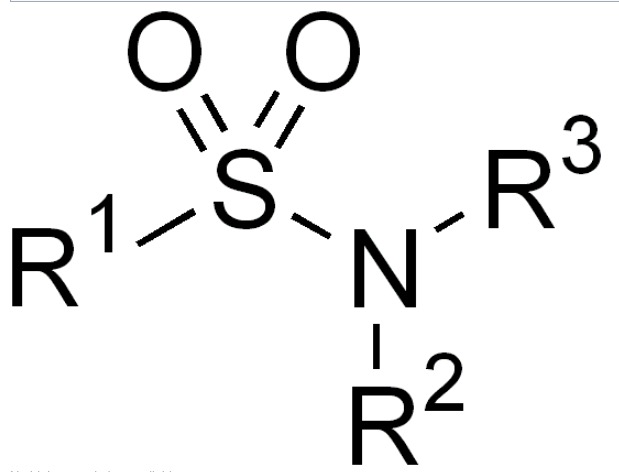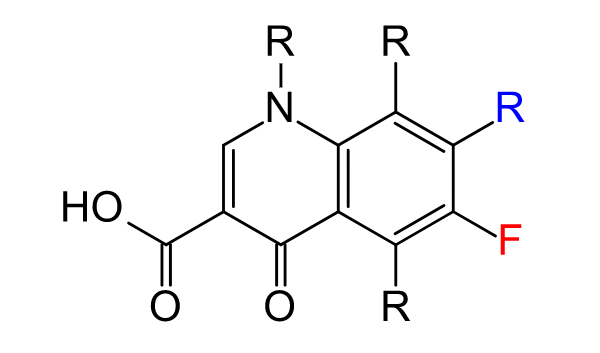Playlist
Show Playlist
Hide Playlist
Overview – Antimetabolites
-
Slides Overview Antimetabolites.pdf
-
Reference List Pharmacology.pdf
-
Download Lecture Overview
00:00 Welcome to Pharmacology by Lecturio. 00:03 I'm Dr.Parvin Shukle. 00:05 We're going to be talking about some unique antibacterial agents in today's lecture. 00:10 What do I mean by unique antibacterials? Well, we've already covered agents that work on the cell wall and agents that work in bacterial protein synthesis. 00:21 What we're going to do right now, is we're going to cover agents that interfere with nucleic acid synthesis and function. 00:26 Sulfonamides, such as sulfamethoxazole, and trimethoprim, are 2 antimetabolites that inhibit the synthesis of folate. 00:35 They are usually given together, abbreviated as TMP-SMX, because they have a synergistic effect by inhibiting consecutive steps in folate synthesis. 00:47 The DNA Synthesis Inhibitors are the fluoroquinolones such as Ciprofloxacin, Levofloxacin, Moxifloxacin. 00:55 They Inhibit DNA gyrase and topoisomerase IV. 00:59 Antimetabolites are essential tools in antibacterial therapy, effectively disrupting the synthesis of purines and thymidine, which are crucial for DNA and RNA production in bacteria. 01:10 Firstly, sulfonamides, such as sulfamethoxazole, act by inhibiting the enzyme dihydropteroate synthase. 01:18 This enzyme is vital for incorporating para-aminobenzoic acid (PABA) into dihydrofolic acid, an early step in folic acid synthesis. By blocking this step, sulfonamides prevent the production of tetrahydrofolic acid (THF), which is necessary for the synthesis of purines and thymidine, thereby halting bacterial growth. 01:39 Trimethoprim works slightly differently. It inhibits dihydrofolate reductase, an enzyme that converts dihydrofolic acid to tetrahydrofolic acid. This inhibition further disrupts the folic acid pathway, preventing the synthesis of purines and thymidine, and consequently, DNA and RNA. 01:59 When used together, as in the combination of trimethoprim and sulfamethoxazole (TMP-SMX), these drugs provide a sequential blockade of the folic acid synthesis pathway. This combination is particularly powerful, as it drastically reduces folic acid levels to lethal levels for bacteria, offering a synergistic antibacterial effect. 02:23 Fluoroquinolones, such as ciprofloxacin, represent another important class of antibacterial agents. 02:30 These drugs inhibit bacterial DNA synthesis by targeting DNA gyrase and topoisomerase IV, enzymes essential for DNA replication and transcription. 02:41 By preventing these critical processes, fluoroquinolones effectively cause bacterial cell death. 02:47 Sulfonamides, commonly known as sulfa drugs, are among the oldest synthetic antibacterial agents. 02:53 They have been used extensively to combat a wide spectrum of gram-positive and gram-negative bacterial infections. 03:00 Despite their age, sulfonamides remain relevant due to their unique mechanism of action and broad efficacy. 03:06 Sulfonamides are structural analogs of para-aminobenzoic acid (PABA), an early intermediate in the folic acid synthesis pathway. 03:16 By mimicking PABA, sulfonamides competitively inhibit the enzyme dihydropteroate synthase (DHPS). 03:23 This inhibition occurs early in the folic acid synthesis pathway, preventing the incorporation of PABA into dihydrofolic acid, a precursor for tetrahydrofolate (THF) synthesis. 03:35 THF is crucial for the de novo synthesis of purines and thymidine, which are essential components of DNA and RNA By blocking the production of THF, sulfonamides effectively halt bacterial DNA and RNA synthesis, providing a bacteriostatic effect that inhibits bacterial growth. 03:53 One of the notable advantages of sulfonamides is their selective toxicity. 03:57 Humans obtain folic acid from their diet, whereas bacteria must synthesize it intracellularly. 04:04 This difference allows sulfonamides to specifically target bacterial cells without harming human cells. 04:11 Sulfonamides are often used in combination with trimethoprim, another antimetabolite that inhibits a later step in folic acid synthesis. 04:20 This combination, using sulfamethoxazole as the sulfonamide, is known as trimethoprim-sulfamethoxazole (TMP-SMX) It provides a sequential blockade of the folic acid pathway. 04:34 The synergistic effect of this combination lowers folic acid production to levels that are lethal to bacteria, making it a powerful antibacterial therapy. 04:44 Trimethoprim is a synthetic antimetabolite antimicrobial compound, widely used in antibacterial therapy. 04:51 Structurally, it is an analog of dihydrofolic acid, allowing it to effectively inhibit bacterial dihydrofolate reductase. 04:59 this enzyme is crucial for converting dihydrofolic acid to tetrahydrofolic acid within the folic acid synthesis pathway. 05:06 By inhibiting this enzyme, trimethoprim disrupts the synthesis of nucleic acids, which are essential for bacterial growth and replication. 05:14 Trimethoprim is most commonly used in combination with sulfamethoxazole, forming the well-known antibacterial therapy TMP-SMX. 05:24 This combination leverages the synergistic effects of both drugs, providing a powerful means of disrupting bacterial folic acid synthesis at multiple steps, thereby enhancing their effectiveness in treating infections. 05:37 Trimethoprim (TMP) combined with sulfamethoxazole (SMX), known as TMP-SMX and marketed as Bactrim and Sulfatrim, works through a sequential blockade of folic acid synthesis in bacteria. 05:51 Sulfamethoxazole blocks the incorporation of para-aminobenzoic acid (PABA) into dihydrofolic acid, a precursor for tetrahydrofolate (THF). THF is essential for the de novo synthesis of purines and thymidine, which are necessary for DNA and RNA synthesis. Trimethoprim inhibits dihydrofolate reductase, preventing the conversion of dihydrofolic acid to tetrahydrofolic acid (THF). 06:20 TMP-SMX is selectively toxic to bacteria because humans obtain folic acid from food, while bacteria need to synthesize it. 06:30 Sequential Blockade lowers folic acid production to levels lethal to bacteria. 06:34 The accompanying images illustrate the uninhibited and inhibited pathways of folic acid synthesis in bacteria. 06:44 Trimethoprim-sulfamethoxazole, marketed under the brand names Bactrim and Sulfatrim, is a versatile antibiotic combination used to treat various infections. It is commonly prescribed for urinary tract infections, acute otitis media, acute exacerbations of chronic bronchitis, shigellosis, Pneumocystis jirovecii pneumonia, particularly in immunocompromised patients, and traveler's diarrhea. 07:10 While TMP-SMX is effective, it can cause several adverse effects, the most common being gastrointestinal disturbances, such as nausea, vomiting, and anorexia, as well as allergic skin reactions, including rash and urticaria. 07:26 Long-term use can lead to bone marrow suppression. 07:30 Additionally, its use in early pregnancy should be carefully considered due to the crucial role of folic acid in fetal development. 07:36 For adults, the standard dosage is 160 mg of trimethoprim and 800 mg of sulfamethoxazole every 12 hours for 10-14 days. 07:46 However, the dosage may vary depending on the specific infection being treated and the patient's renal function. 07:53 Fluoroquinolones, such as ciprofloxacin, are powerful bactericidal antibiotics. 07:58 They work by targeting two essential bacterial enzymes involved in DNA replication and transcription: DNA gyrase and topoisomerase IV. 08:07 In gram-negative bacteria, fluoroquinolones bind to the DNA gyrase-DNA complex, stabilizing the normally transient double-strand breaks that the enzyme introduces. 08:18 This stabilization prevents the re-ligation of DNA strands, leading to the accumulation of double-strand breaks, which blocks DNA replication and results in bacterial cell death. In gram-positive bacteria, topoisomerase IV is crucial for separating interlinked daughter chromosomes after DNA replication. 08:38 Fluoroquinolones stabilize the enzyme-DNA cleavage complexes formed by topoisomerase IV, preventing the re-ligation of DNA strands. 08:47 This action also leads to double-strand breaks, halting DNA replication and transcription, and ultimately causing bacterial cell death. 08:56 Fluoroquinolones indirectly affect RNA synthesis by disrupting DNA processes Their selective toxicity is due to their preferential binding to bacterial DNA gyrase and topoisomerase IV, with higher concentrations required to impact human enzymes. 09:13 This provides a therapeutic window effective against bacteria while being safe for humans. 09:18 Fluoroquinolones are broad-spectrum antibiotics effective against both gram-positive and gram-negative bacteria, making them versatile in treating a variety of infections. They have potent activity against a wide range of gram-negative bacteria. 09:32 Ciprofloxacin, for example, is highly effective against Pseudomonas aeruginosa. 09:37 Their activity against gram-positive bacteria is more variable. 09:41 However, newer fluoroquinolones like moxifloxacin and others have enhanced activity against gram-positive organisms. 09:49 It's important to note that resistance can develop, particularly in methicillin-resistant Staphylococcus aureus (MRSA). 09:57 They are often used to treat fespiratory Infections, including common respiratory pathogens, including penicillin-resistant Streptococcus pneumoniae and Haemophilus influenzae. 10:08 They are effective for both complicated and uncomplicated urinary tract Infections, with ciprofloxacin and levofloxacin being commonly used. 10:17 Fluoroquinolones are also used to treat gastrointestinal infections, bone and joint infections, and certain sexually transmitted diseases Common Adverse Effects include gastrointestinal disturbances, central nervous system effects, and phototoxicity. 10:34 More severe but less common adverse effects include tendinitis and tendon rupture, especially in patients taking corticosteroids, and QT interval prolongation. 10:44 For ciprofloxacin, the adult dosage 250-750 mg orally every 12 hours for most infections and 400 mg IV every 12 hours for severe infections. 10:55 For levofloxacin, the adult dosage is 500-750 mg once daily, depending on the severity and type of infection.
About the Lecture
The lecture Overview – Antimetabolites by Pravin Shukle, MD is from the course Antimicrobial Pharmacology.
Included Quiz Questions
Which one of the following is NOT one of the 4 classic antibacterial classes?
- Agents that require metabolism to become active
- Agents that interfere with bacterial cell wall synthesis
- Antimycobacterial agents
- Agents that interfere with nucleic acid synthesis
- Agents that interfere with protein synthesis
Customer reviews
5,0 of 5 stars
| 5 Stars |
|
1 |
| 4 Stars |
|
0 |
| 3 Stars |
|
0 |
| 2 Stars |
|
0 |
| 1 Star |
|
0 |
Just want to say that this lecturer is gold. He speaks clearly, does not refer to items not present on the slide (thus confusing the learner), and excellent at teaching. Really enjoying all your lectures Dr. Shukle.





